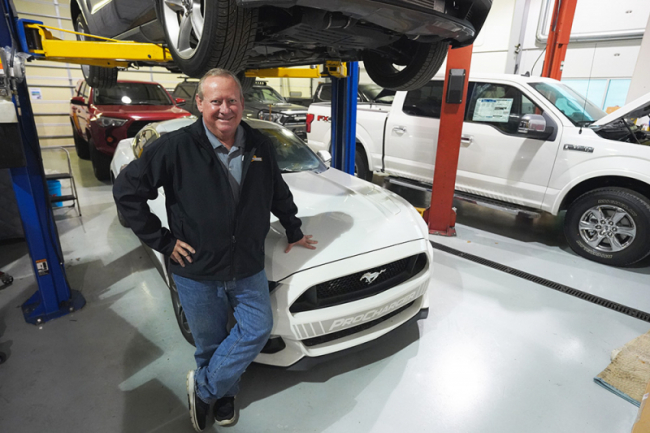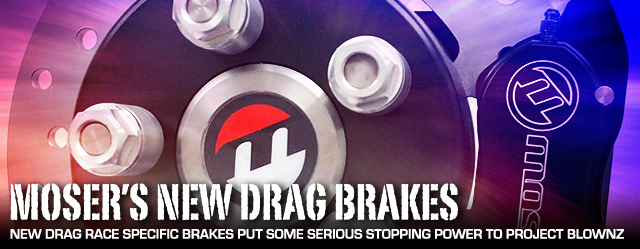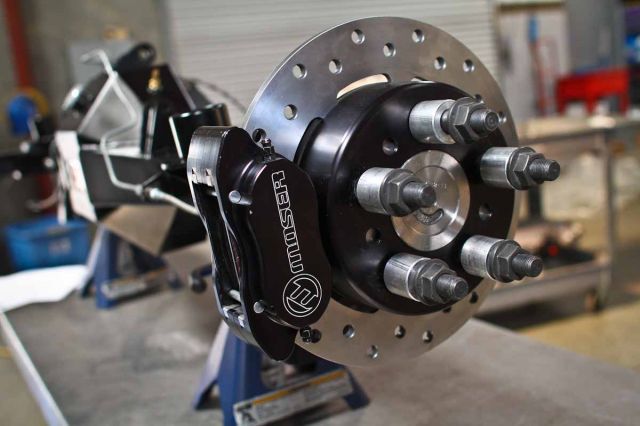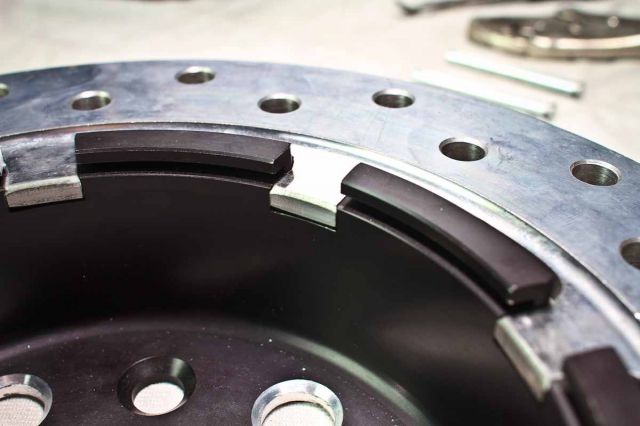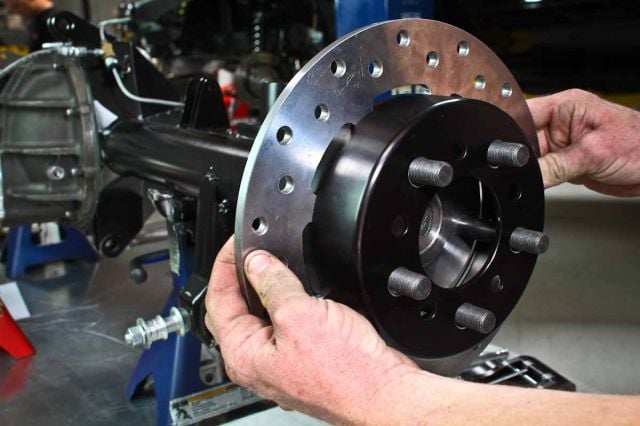Drag racing is all about acceleration, which requires making the most power possible and sticking it to the ground with the most available traction, ultimately resulting in a lower elapsed time than the other guy. There are a million variables involved in all of that, and in getting a car to be the most efficient that it possibly can be, we often get lost in the sole pursuit of the finish line. But if you’ve ever passed the traps at 175 mph, you understand the importance of the other side of the coin—slowing that substantial mass down before you end up in the sand trap and catch fence at the end of the track. That’s never a good way to end a race weekend. Thus we turned to Moser Engineering for some serious stopping power on our Project BlownZ.
As with every car since the beginning of time, you’ve gotta’ have brakes, plain and simple. Even with a parachute to scrub off the big speed, you still need binders on the axles to bring the thing to a stop, or at least slowed enough for the turnout and return road. In a drag race situation, where weight is the enemy of performance, you want the lightest brakes that will still stop the car. The heavier the car, the bigger and thicker the brakes need to be.
Back in the day, when drum brakes were still being produced, many racers would actually remove their factory disc brakes and replace them with the lighter drum assemblies. Drums don’t work as well, or as reliably, as discs, and they require more maintenance, but compared to old-style factory discs, they were indeed a little bit lighter.
Moser Engineering’s Performance Drag Brake Kit
• Competition Race Series 4-piston aluminum rear brake kit
• Calipers are constructed from 6061 T6 Billet Aluminum
• Assembled with stainless steel pistons and Teflon coated one piece bleeder screws
• All kits supplied with Hawk brake pads • Dual pad pin design with o-rings to eliminate pad chatter
• Claimed 25% more pad contact area than other competing calipers
• Track tested and 100% made in the USA
• Kit includes 2 Calipers , pad pins, 1 set of Hawk HP PLUS pads, mounting brackets, billet aluminum hats, 3/8” drilled rotors.
To solve the dilemma, a few companies came out with drag-only disc brakes. These kits replaced the heavy, stock vented rotors with lightweight and small-diameter solid rotors. The advantage is the performance of disc brakes with less weight, but the disadvantage is that these smaller rotors will only take a really hard stop once before they get hot and need to be cooled down. That’s why every solid-rotor drag brake you see on the market is labeled “race only”—try to drive the car down a twisty mountain road with drag brakes and you’ll experience first-hand what brake fade—then no brakes at all—is all about.
Moser Engineering’s Performance Drag Brakes
Inside the caliper are stainless steel pistons, and dual pins are used for pad retention with O-rings to eliminate pad chatter. The pins also make pad changes quick and easy. As a drag race-specific design element, Moser incorporated dual fluid crossover ports for the quickest caliper release possible, to get the car moving and off the line faster.
Moser didn’t just copy another manufacturer’s kit; they started with a clean sheet of paper and a list of stuff they didn’t like in other brake systems, and designed their own. Starting with the caliper, arguably the most complicated part of the brake system, Moser designed a competition, race-series, 4-piston caliper, forged from 6061-T6 billet aluminum. This is more expensive but infinitely better in every way than a factory-style cast iron caliper. It’s lighter too.
Left to right: The calipers are forged from 6061-T6 billet aluminum and come black anodized with the Moser etching. One-piece, Teflon-coated bleeder screws on both sides ease bleeding. Make sure when you install the calipers that the bleeder screws point up or you’ll never get the air out of the system. The four pistons are stainless steel for long wear. Two pins hold the pads in place and are secured with cotter pins. This also makes pad changes fast.
The Grunt Work: Pads And Calipers
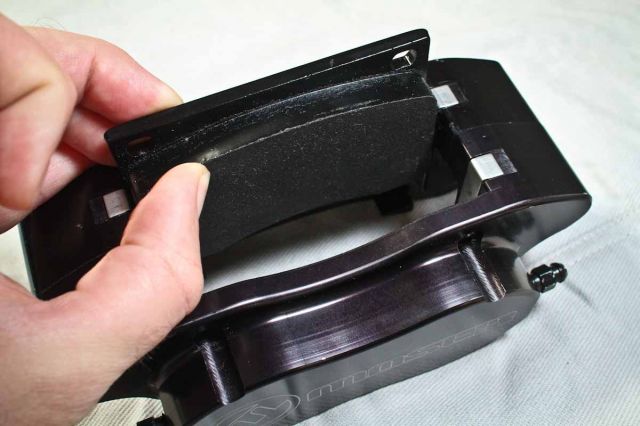
The pads are sourced from Hawk, a leading supplier to the racing world, and they are available off-the-shelf at any decent parts store.
For pads, Moser went straight to Hawk, who supplies pads to pretty much everyone including high-end road race teams. Jeff Anderson, Moser’s marketing director, said, “The brake pads themselves are out sourced to Hawk who has years of expertise, and when it comes to brake pad compounds, we felt they were supplying some of the most competitive pads you could buy, so why reinvent the wheel.” Another nice touch is that the Hawk D43 pad that comes with the Performance Drag Brake kit is available off-the-shelf at any local parts store.
While the caliper is a fairly conventional design, the disc itself is quite a departure from what we’ve seen before. A lightweight brake kit almost always uses a two-piece rotor design, with a cast-iron rotor (aluminum won’t handle the heat) and an aluminum hat (the part that the lug studs go through). In the case of other designs, the rotor and hat are bolted together, but Moser’s research proved that this solid connection between metals of two different expansion rates promotes warping under heat. Not only does that ruin the assembly, or at least the rotor, it makes it very difficult if not impossible to remove the rotor-to-hat bolts if you want to replace the rotor.
Instead of bolts, the Moser disc and hat are held together with this snap ring.
Moser’s Brand New Design
Moser’s revolutionary solution was to attach the hat to the rotor with a snap ring. The drilled rotor is keyed and slotted and uses a spiral retaining ring to attach them, which allows more radial growth during the high temperature cycle of a hard stop from high speed. That helps reduce the sticking and warping that occur in most other designs under heavy braking—it allows for some “breathing room,” if you will, during the different rates of expansion.
The combination of the thin, solid rotor and the caliper design together allows for 25-percent more pad contact area than other calipers on the market, according to Moser, and also makes room for a 20-percent thicker pad material for longer wear.
The kit is available for every popular housing end -- in our case the Ford Torino 2.5-inch big brake ends. The caliper bracket slips on and attaches like this; you don’t have to remove the axle. Project Blown Z makes a lot of power, so we used beefy 5/8-inch wheel studs in our Moser 40-spline axles, which we specified to Moser for the kit so the hats came drilled for that size. After installing the pads in the caliper, it bolts on like any other caliper.
The Moser Engineering Performance Drag Brake kit comes with two calipers, pad pins, one set of Hawk black pads, mounting brackets, billet aluminum hats, and 3/8-inch-thick drilled rotors. They are available for any popular rear end housing or housing ends, and like all of Moser’s parts, are 100-percent made in the U.S.A. and completely track-tested.
An option is a dual-caliper rear brake system based for the high-end of the Sportsman drag racer ranks that uses the same quick pressure-relief system to get the car off the line quicker along with Moser’s revolutionary dynamic mount that eliminates a lot of the maintenance problems associated with kits made over the last two decades.
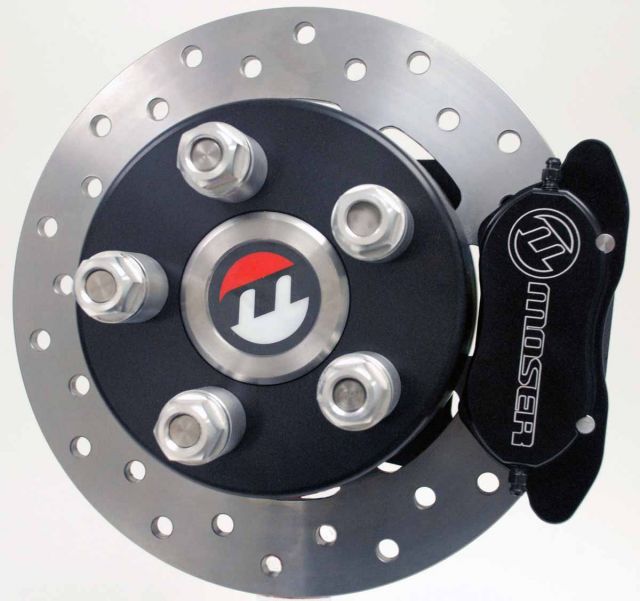
In addition to our stock front discs, the finished Moser Performance Rear Drag Brakes should bring the Camaro down from a buck-seventy without drama.
Installing the rear brakes on our Project Blown Z Camaro was about as easy as it gets. You’ll need to assemble the rotor/hat combination but that’s super-easy; the rest slips together like any other brake system, but easier since it’s so light. To connect it to the hydraulic system, we used Fragola Performance Systems stainless steel brake hoses with 90-degree ends at the caliper.
The 6000 Series P.T.F.E.-lined stainless steel hoses we chose from Fragola are designed for highly corrosive applications such as automotive brake fluid, and they’re also a great choice if you need a product for hot oil, brake fluid, or power steering fluid. These hoses are created when P.T.F.E powder is extruded into a smooth bore tube, which is then fed into a machine that weaves stainless wire into the braided pattern. The result is a tough product that won’t scratch aluminum panels or remove paint.
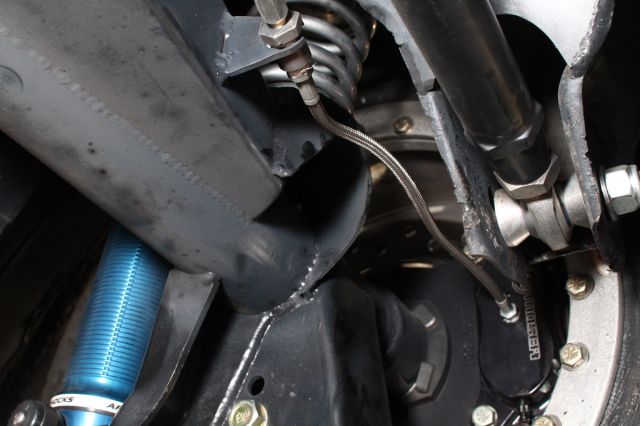
Here you can see the Fragola stainless steel brake line running over the rear end housing to the rear brakes.
Fragola offers these 6000 Series stainless hoses in complete pre-made assemblies in either -3 or -4AN line with a number of fitting options. Four our needs, we opted for crimped NPT ends that are 10-inches long per side. Other options include matching straight fittings, 45-degree angles, 90-degree angles, and more. One can also order custom factory-crimped assemblies, as well.
The Moser calipers also use a Teflon-coated bleeder screw that makes purging the system of air easy.
Once the car gets finished and ready to make a seven-second blast down the quarter-mile, we’ll have no worries about standing on the brakes to bring it down to speed, thanks to Moser’s new Performance Drag Brakes Kit.


